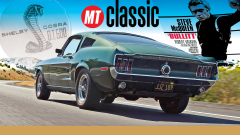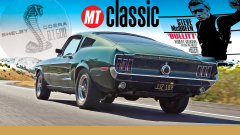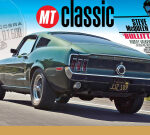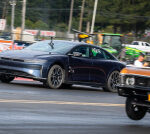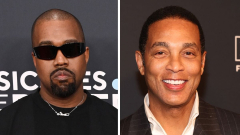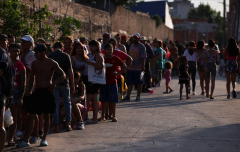[This story first appeared in the September/October 2006 issue of Motor Trend Classic.] Fact: The chase scene from the 1968 movie Bullitt was, is, and remains the best ever filmed. There have been some valiant challengers: the late John Frankenheimer’s heart-pounding work through the streets of Paris in Ronin; making Minis fly in The Italian Job (the original and the remake); the Seven-Ups, which involved some of the same folks who worked on Bullitt. But when the lists are made and the bets are laid down, Bullitt comes out on top. Every time.
In spite of a few charming continuity goofs and cameras occasionally visible in the back seat of Lieutenant Frank Bullitt’s tire-smoking Mustang fastback, the scene was lauded for its authenticity and realism at the time. See it on a big screen today, and the views out the windshield as the Mustang and bad guys’ Dodge Charger careen down San Francisco’s Taylor Street will still make your stomach roll.
Our mission was to return to the City by the Bay in a faithfully recreated replica of the Bullitt Mustang, drive the chase-scene route, and hit a few other iconic locales used during filming.
The Flick
Any car fool worth his tweed blazer and blue turtleneck will be familiar with the movie and the great chase, but if not, here’s a quick rundown: Steve McQueen plays Frank Bullitt, a grizzled veteran investigator with the San Francisco P.D. His girlfriend is the nubile Jacqueline Bisset, and the reptilian politico villain is played by Robert Vaughn at his best. You’ll spot worthy performances by Norman Fell and McQueen pal Don Gordon, and a young Robert Duvall cameos as a cab driver. Brit Peter Yates directed. From its earliest iterations, the script called for an “automotive action scene”; this was likely one of the reasons McQueen and his Solar Productions were involved in the first place. The actor insisted on absolute realism, with no camera speedups, and of course this was long before the notion of computer-generated animation. The rest of the plot is inconsequential to this exercise.
Ford was the official car provider for the movie, the main four-wheeled characters being two 1968 Mustang GT 390s, painted that now famous shade of Highland Green Metallic. The cars carried back-to-back serial numbers, and although rumors persist that one was really a 302-powered car and one had an automatic trans, hard-core Bullitteers have vetted the build codes and confirm both were 325-horse, big-block, four-speed models.
The apartment building Frank Bullitt calls home.
Race-car driver and constructor legend Max Balchowsky (of Old Yeller fame) was called upon to modify the cars for heavier-than-routine duty. Suspensions were beefed up, as were their pickup points. Koni adjustable shocks were installed, along with numerous camera mounts. The stock exhaust systems retained their small glasspack mufflers, but lost the transverse muffler in favor of straight pipes out the back, all the better to hear the thumping 390s. Stories vary as to the level of engine mods. The Mustangs had manual steering and no air-conditioning.
Equally important is what’s not there. All the badging was removed, and various chrome pieces were painted black or body color. All the chrome pieces from the grille were binned. The stock wheels were swapped for 15-inch American Racing Torq-Thrust D mags. McQueen had the stock, none-too-pretty steering wheel replaced with a 1967 Shelby piece, which his pal, hotrod upholstery guru Tony Nancy, wrapped in leather for him. The look was menacing to say the least.
Chalmers’s house looks as it did in 1968 and is one of SF’s most desirable and expensive residences.
McQueen did most of the driving himself, although some of the riskiest passages were handled by stunt masters Carey Loftin and Bud Ekins (the same guy who, at the producers’ insistence, rode for McQueen in the motorcycle jump scene in The Great Escape). The villains’ famously black 1968 Dodge Charger, as manhandled about by actor/stunt driver Bill Hickman, is an equally integral plot element. Two matching Chargers R/Ts were employed, equipped with 375-horsepower, single four-barrel 440-cubic-inch Magnum V-8s and four-speed transmissions (it’s possible one may have had an automatic). Although they were R/T models, the movie Chargers ran more conservative hubcap and whitewall rolling-stock combos. That’s an important point because, if they’d had Magnum 500 or alloy wheels, they wouldn’t have been able to toss away all those hubcaps during the chase scene. Ekins and McQueen went to a nearby racetrack and practiced driving side by side at over 100 mph in preparation for all the stuntwork.
The market where Bullitt stocks up on food and swipes a newspaper when nobody’s looking.
There’s no question the Charger’s large, flat body panels, hideaway headlights, and black grille and paint job helped create the ominous look. Modifications were minimal: The torsion bars were shortened, the control arms beefed up, and police-spec rear springs were installed; but the powertrains were stock. One of the Big Bad Dodges was totaled in the filming of the chase’s final scene (although it actually missed the gas station set, which was blown up by remote control), while the other also has been confirmed as destroyed.
The 10-minute-or-so chase sequence was filmed during May 1968. The crew for any given scene numbered 50 to 60, including the actors, stuntmen, and drivers, plus camera, sound, and communications people. Because of some clever editing—Bullitt received an Oscar for it—the scene flows seamlessly from location to location. Contrary to popular belief, however, the various locales are disjointed, and the chase route cannot be driven as it appears. Several Web sites have maps of the chase locales; one is ponysite.de/location.htm. Bullitt was recently released as a two-disc DVD set and belongs in any car freak’s library.
The Car
“I’ve loved this movie since I first saw it as a kid,” says Dave Kunz, a reporter/cameraman for ABC in Los Angeles. He’s also a consummate car enthusiast and Mustang lover. He bought his Highland Green 1968 Mustang GT 390 in November 1992. “It was bone stock, in clean condition, and even though it was the same model and color as the ‘Bullitt’ movie cars, I had no initial intention of building a replica. A few things in my garage tumbled onto it during the 1994 Northridge earthquake, gouging the paint. My insurance company paid to have it stripped and redone. I visited the paint shop before the white C-stripes and some of the chrome trim was reinstalled. Something clicked, and before I knew it, I was looking at movie photos trying to figure out the rest of the details.”
Kunz’s Mustang is a faithful, but not exact, replica. It has power steering and air-conditioning. It also has a lower console and retains the chromed rear lettering, chrome taillight trim, and dual side mirrors. But other trim bits have been removed, the lower rocker trim painted body color, the grille-mounted horse emblem and driving lights pulled out, the exhaust system modified, a close replica of McQueen’s favorite 1967 Shelby Mustang steering wheel installed, proper American Racing Torq-Thrust D wheels and Koni shocks bolted on, and numerous other details affected to make the car a convincing twin to the cars McQueen, Ekins, and Loftin bashed around the hills of San Francisco.
Kunz Mustang detailing includes metal repop “JJZ 109” plate, close-to-correct steering wheel, and autographs by Sheryl Crow and Chad McQueen.
Kunz doesn’t go out of his way to market or promote the car as an official replica, but he’s friendly with Ford, which has used the car a number of times in that capacity. It appeared in a TV commercial filmed for the launch of the Ford Puma and also in Sheryl Crow’s music video for her song “Steve McQueen.” Ford used the car during its launch of the 2001 Bullitt Mustang, and it’s been autographed by Sheryl Crow and Chad McQueen. Like Ms. Crow and Mr. McQueen the younger, it’s become a bit of pop culture in and of itself.
The Drive
There was no Transamerica building on the San Francisco skyline when Bullitt was filmed in 1968. The hotel where Frank Bullitt attempts to protect a witness was destroyed in the Loma Prieta earthquake in 1989. What’s called the “Thunderbolt Motel” in the film is a Clarion today. But an amazing number of the iconic locations in the movie appear much as they did then, even after nearly 40 years.
The chase scene takes place primarily in the Russian Hill area of San Francisco and south of the city in the Guadalupe Canyon Parkway vicinity of Daly City. It never involves the Mark Hopkins hotel, but that’s where we begin our pilgrimage, because after a brief opening scene in Chicago, the first footage after the story segues to San Francisco was shot in front of the Mark. Our next stop is Chalmers’s (Robert Vaughn) house at 2700 Vallejo Street at Divisadero in Pacific Heights. This is where Chalmers and Bullitt meet for the first time, and you can tell it’s not going to be a beautiful friendship. The house is a stunning piece of real estate in one of the city’s nicest areas, looks immaculate in the movie, and still does.
Alcatraz Island is visible in this shot taken from the chase route on Larkin Street.
Then it’s on to the corner of Clay and Taylor streets. This exact intersection isn’t in the chase scene, either, but it’s where Bullitt’s apartment is located. The ground-floor unit has since been converted to a garage, and we believe Bullitt occupied the second- or third-floor apartment. Across the street is the liquor and grocery shop where Bullitt purchases an armload of frozen dinners (and some green onions) then walks outside, gives the newspaper machine a pop with his fist, and steals a paper. “People still walk up to that paper machine and pound on it,” says the store’s current owner. “They still remember.” A lone photo of McQueen hangs near the entrance.
Army Street just off Highway 101, where the chase begins to form, has been renamed the ubiquitous Cesar Chavez Blvd. The car wash seen in the film is gone, and some roadwork has changed the landscape. But one landmark a few miles away, Bimbo’s 365 nightclub at 1025 Columbus Avenue, looks exactly as it does through the Mustang’s windshield, when at approximately one hour, eight minutes, and 30 seconds into the film, stunt driver Bill Hickman fastens his seatbelt, mash

